|
|
|
Sort Order |
|
|
|
Items / Page
|
|
|
|
|
|
|
| Srl | Item |
| 1 |
ID:
105128
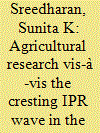

|
|
|
|
|
| Publication |
2011.
|
| Summary/Abstract |
Innovative resource use or 'jugaad' by ordinary Indian has contributed immensely to adapting to hardships on the one hand and adding to the global knowledge bank on the other hand. In the present era, India possesses one of the more elegant IPR systems in the world, although the newly enacted laws have encountered minor hiccups. In fact, it was an Indian agricultural product (Basmati rice) that caused a furore over three continents on three different aspects of intellectual property laws in the last decade of the 20th century. However, the 21st century seeks answers to problems beyond the major milestones in Indian agriculture (the green and white revolutions) to tackle the problems of food security and volatile food prices. The gap in the perception of researchers and legal acumen needs to be bridged; wherein IP audit is an important tool to assess and project the intellectual properties of clients. This paper attempts to synthesize a well-knit idea for IPR awareness in agriculture sector using sectoral as well as external examples.
|
|
|
|
|
|
|
|
|
|
|
|
|
|
|
|
| 2 |
ID:
100070


|
|
|
|
|
| Publication |
2010.
|
| Summary/Abstract |
The primary purpose of this article is to examine the extent to which Canada's copyright laws permit the creation of machinima, an art form broadly defined as the creation of films within video games. This article is structured as follows. First, it will introduce machinima, discussing its origins, its development and its social importance. Second, it will examine whether the acts of creating and distributing machinima infringe copyright in Canada. Third, it will ask whether there are any defences to copyright infringement on which machinimators (those who create machinima) can rely. This article will demonstrate that, in many cases, the creation and distribution of machinima likely infringes Canadian copyright law. Furthermore, a large percentage of machinima that are found to infringe copyright will not be protected by the fair dealing defence as it is currently being applied by Canadian courts. This article will conclude by situating the narrow issue of machinima and copyright infringement within the broader context of creativity and copyright reform in the digital age.
|
|
|
|
|
|
|
|
|
|
|
|
|
|
|
|
| 3 |
ID:
115617
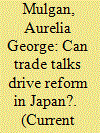

|
|
|
| 4 |
ID:
076679
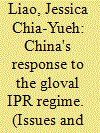

|
|
|
| 5 |
ID:
105133


|
|
|
|
|
| Publication |
2011.
|
| Summary/Abstract |
A survey under United Nations Conference on Trade and Development project in 25 states of India identified promising indigenous drinks that merit protection as Geographical Indications (GI) including 'nannari' from Andhra Pradesh, 'kokum' from Western Ghats and 'burransh' from Uttarakhand. These are obtained from roots of Hemidesmus indicus, fruits of Garcinia indica and flowers of Rhododendron arboretum, respectively. Manufacturing procedures involving application of community traditional knowledge, and ethno-medicine properties are scientifically documented. Product acceptability by the retailers and consumers is high; hence companies would be willing to invest in such products. Here, one of the important issues to be addressed is benefit sharing with traditional knowledge holders and alleviation of their socio-economic condition. Producers are unorganized and dispersed with seasonal employment and are not known outside restricted area. Therefore, can GI be a platform for product and market development addressing socio-economic issues? The products have a sufficient niche market since per capita fruit juice consumption in India is only 20 ml. Market demand is expected to increase from 27.4 to 64 billion rupees by 2020 with 8.9 per cent market growth, with 65 per cent market share restricted to South India. In such a scenario, can registered GIs accelerate the growth through market penetration? The study offers solutions/models for GI registration and business strategy with sustainable rural livelihood development.
|
|
|
|
|
|
|
|
|
|
|
|
|
|
|
|
| 6 |
ID:
105120
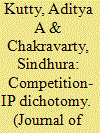

|
|
|
|
|
| Publication |
2011.
|
| Summary/Abstract |
Technology transfer agreements are necessary to fulfil technological needs that are impossible to meet with local technical capabilities. Traditional devices of licence transfer often fall within the purview of antitrust scrutiny and are deemed anti-competitive practices in general trade, as in the case of territorial restrictions in licensing. Antitrust laws, although fit to evaluate general trade agreements, often fail to address intricate problems involving IPR and therefore, lack the tools to adequately solve them. The blanket protection approach to IP as provided by Section 3(5) of the Indian Competition Act is equally ineffective due to lack of a mechanism to deal with IP-related unfair trade practices. The TRIPS under Article 40, permits member states to prevent abuse of IP through anti-trust legislations. India has permitted cross licensing under its patent laws but has failed to prevent its anti-competitive fallout in technology licensing. This article draws from the EU TTBE 2004 Regulations as well as the US antitrust guidelines to highlight the need for a balance between the two conflicting interests of competition policy and the protection of technological know-how. It further purports to set forth an adaptation of guidelines for India, keeping in mind the anti-trust laws of other jurisdictions.
|
|
|
|
|
|
|
|
|
|
|
|
|
|
|
|
| 7 |
ID:
110290
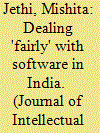

|
|
|
|
|
| Publication |
2011.
|
| Summary/Abstract |
Section 52(1)(ab) of the Copyright Act, 1957 deals with the fair use exception in case of computer software. This paper attempts to analyse the scope of this exception when applied to software as a work of art in India. The right to decompile, as found in different countries and enactments, is compared with the Indian position. It is argued that this right must be given very strictly. The Indian position on the right to decompile is very nebulous. The statutory guidelines are insufficient and poorly drafted, leaving the limits of this right uncertain. Allowing decompilation without placing distinct restrictions on how to use such extracted information, completely outweighs the reasoning of fair use doctrine. Inadequate guidelines as to the extent to which a program may be reverse engineered and who is allowed to reverse engineer, leaves loopholes in the protection of software copyright, allowing circumvention of copyright and the defence of fair use while commercially exploiting competing interoperable programs. The paper concludes by stating that with the growing rate of peer-to-peer sharing in India, this exception, unless narrowed down in its scope, may go beyond mere fair use and may be used to circumvent liability for infringement of copyrighted software.
|
|
|
|
|
|
|
|
|
|
|
|
|
|
|
|
| 8 |
ID:
085788
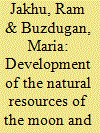

|
|
|
|
|
| Publication |
2008.
|
| Summary/Abstract |
The path of gradual commercialization of current space applications, such as launch services, satellite communication services, direct broadcasting services, satellite remote sensing and navigation services, and satellite weather monitoring services, will most likely be followed by future activities of use of space resources. Ventures, like mining the natural resources of the Moon and asteroids, are likely to become technologically feasible in the near future. The question is what would be the most appropriate approach to address the future needs of exploitation of space resources: should it remain the exclusive province of state governments; should the private sector take over such space activities; or should a public-private partnership type of venture be encouraged? As state governments are becoming constrained by budget deficits, an increased reliance on private sector involvement in space activities involving the extraction and use of space resources is to be expected. When deciding whether to invest in commercial ventures of resource use exploitation, any potential private investor will be faced with the issues of economic costs, risks, and perceived regulatory barriers. This study argues that the perceived regulatory barriers, i.e., the licensing requirement, the "common heritage of mankind" principle of international space law, and protection of intellectual property rights, are not obstacles to economic development. Governments should provide both policy and regulatory incentives for private sector participation in the area of space natural resource use by funding basic research and development and by sponsoring liability insurance for private ventures among other incentives.
|
|
|
|
|
|
|
|
|
|
|
|
|
|
|
|
| 9 |
ID:
101203
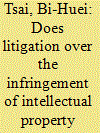

|
|
|
|
|
| Publication |
2010.
|
| Summary/Abstract |
This paper seeks to clarify the relationship between intellectual property right (IPR) infringement lawsuits and innovation by firms through an analysis of data from eighty-seven Taiwanese integrated circuit (IC) manufacturers in the period 2001-2006. The results show that the rapid growth in patent grant is positively related to the occurrence of patent infringement lawsuits, which implies that IPR infringement litigation strengthens firms' incentives to innovate. Patent holders adopt an "aggressive strategy" that makes use of the offensive function of patents to initiate lawsuits against alleged violators. The defendants then adopt a "regressive strategy" by building up "patent walls" to refute the charge and defend themselves. In addition, Taiwanese IC firms are more inclined to develop patents when they are defendants rather thanwhen they are plaintiffs. This suggests that the defensive function of patents has a more profound impact than the offensive function for Taiwanese IC firms. These firms do not possess the core technology needed in IC-relatedmanufacturing processes,and they have in the past applied other firms' technology without obtaining legal licenses. In response to accusations of infringement, Taiwanese IC firms adopt a "regressive strategy," encouraging their employees to develop patents which they then use to refute the charge of IPR infringement.In addition, it is found that stock-based bonuses are a better incentive for encouraging employees to develop patents for their firms.
|
|
|
|
|
|
|
|
|
|
|
|
|
|
|
|
| 10 |
ID:
021937
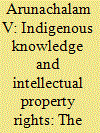

|
|
|
|
|
| Publication |
May 2002.
|
| Description |
222-232
|
|
|
|
|
|
|
|
|
|
|
|
|
|
|
|
| 11 |
ID:
184017
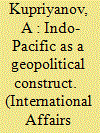

|
|
|
|
|
| Summary/Abstract |
GEOPOLITICAL constructs are a relatively new phenomenon in global political practice, and even today they are often created spontaneously. One of the most complex, contradictory, and ambiguous geopolitical constructs is the Indo-Pacific Region (IPR), or the Indo-Pacific, as it is known for short. It entered global political discourse in 2007, with the publication of an article by Gurpreet Khurana on sea lanes of the Indian and Pacific Oceans. According to some experts, the term "Indo-Pacific" has recently become a buzzword widely used by politicians and political analysts to show that they keep abreast of current trends, but it also helps perpetuate the Indo-Pacific idea
|
|
|
|
|
|
|
|
|
|
|
|
|
|
|
|
| 12 |
ID:
021973
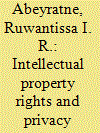

|
|
|
|
|
| Publication |
July 2002.
|
| Description |
631-650
|
|
|
|
|
|
|
|
|
|
|
|
|
|
|
|
| 13 |
ID:
021949


|
|
|
|
|
| Publication |
July 2002.
|
| Description |
308-323
|
|
|
|
|
|
|
|
|
|
|
|
|
|
|
|
| 14 |
ID:
090963


|
|
|
| 15 |
ID:
105129
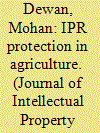

|
|
|
|
|
| Publication |
2011.
|
| Summary/Abstract |
Private rights in living objects have always been controversial. Agriculture provided the first wave in human civilization. Therefore, agriculture including plant breeding and agricultural methods pre-dated any form of IPR protection unlike industry and commerce. Traditionally, IPR was not applied to agriculture. In recent times, this position has changed and increasingly agriculture is seen as an industry that cannot survive without research and development and astute investments. This has made it necessary that IPR in all its forms be extended to agriculture.
|
|
|
|
|
|
|
|
|
|
|
|
|
|
|
|
| 16 |
ID:
032260


|
|
|
|
|
| Publication |
Washington, U S Government Printing Office, 1981.
|
| Description |
v, 421p
|
|
|
|
|
|
|
|
|
|
|
|
Copies: C:1/I:0,R:0,Q:0
Circulation
| Accession# | Call# | Current Location | Status | Policy | Location |
| 020943 | 345.02540955/US 020943 | Main | On Shelf | General | |
|
|
|
|
| 17 |
ID:
110315
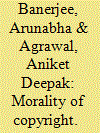

|
|
|
|
|
| Publication |
2011.
|
| Summary/Abstract |
This article seeks to examine debatable issues that have arisen following the controversy involving author's rights after the release of the film '3 Idiots' based on Chetan Bhagats's novel '5 Point Someone'. The fact that Bhagat failed to get due recognition in the credits of movie along with alleged mutilation of the original work raises the question of recognition of moral rights in India. Following the 1994 amendment, copyright law has drifted away from the objective of viewing a work as an integral expression of the author's personality - probably reason why contracts continue to dictate the rights and obligations of parties in such transactions. This article throws light on the need to restore focus on these legitimate concerns by undertaking a critical comparison of the position under foreign laws. The difference in the perspectives of common law and civil law countries in treating the issue of morality of copyright has been marked. A number of illustrative case laws and international conventions have been discussed under various jurisdictions to cull out the basic tenets of moral nature of copyright. The article also puts forth certain suggestions to address the legal concerns.
|
|
|
|
|
|
|
|
|
|
|
|
|
|
|
|
| 18 |
ID:
110490
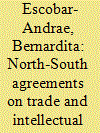

|
|
|
|
|
| Publication |
2011.
|
| Summary/Abstract |
This article lays out qualitative and quantitative information of the extent of intellectual property (IP) protection reached by industrial property related sections of US bilateral trade agreements (TAs) agreed during 2000 decade. The paper classifies IP protection provisions of such TAs. Their extent of protection is measured through the identification of 'shall+' commitments, i.e. compulsory commitments that imply protection beyond WTO-TRIPS benchmark. The metrics built highlight the fact that despite significant similarities in structure and content found across TAs, there is a notable dispersion in the extent of protection they contain. Indices produced show that pharmaceutical provisions comprise a significant part of 'shall+' commitments of such agreements. This finding supports the hypothesis of pharmaceutical industry's success in setting the agenda for US international trade and IP policy1 and the role that IP protection plays in such industry.2, 3 The extent of IP protection is highly correlated across IP categories and they reveal that Chile agreed to the lowest number of such commitments, whilst Oman and CAFTA agreed to the greatest number of such provisions. Duration of negotiations appears to be negatively and significantly correlated with indices for patent and data protection for pharmaceuticals. This finding suggests that such provisions indeed became the core of the negotiations, and countries that strove to limit their inclusion, succeeded partially.
|
|
|
|
|
|
|
|
|
|
|
|
|
|
|
|
| 19 |
ID:
095059
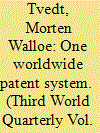

|
|
|
|
|
| Publication |
2010.
|
| Summary/Abstract |
This article offers a discussion of the probable effects of a Worldwide Patent System for developing countries. It draws upon insights from the ongoing processes in the World Intellectual Property Organization and elsewhere relevant for the global patent system and discusses these features from a developing country perspective. For scientifically advanced developing countries the effect in their most advanced and most global enterprises is potentially positive as they will benefit as much as other multinational companies. In areas of research and development where these most advanced developing countries do not possess a high level of technological capacity, a Worldwide Patent System is unlikely to create any benefits for them. For countries with the ability to copy and produce inventions made by others a Worldwide Patent System will have a negative effect as inventors will have little opportunity to utilise the system, whereas they will be bound by a larger number of exclusive rights narrowing down their space for innovation. For the least developed countries an additional problem arises: it might become even more difficult to import essential goods because patents will be in force in these countries even though there is no production of that product in the country.
|
|
|
|
|
|
|
|
|
|
|
|
|
|
|
|
| 20 |
ID:
021938
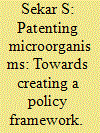

|
|
|
|
|
| Publication |
May 2002.
|
| Description |
211-221
|
|
|
|
|
|
|
|
|
|
|
|
|
|
|
|
|
|
|
|
|